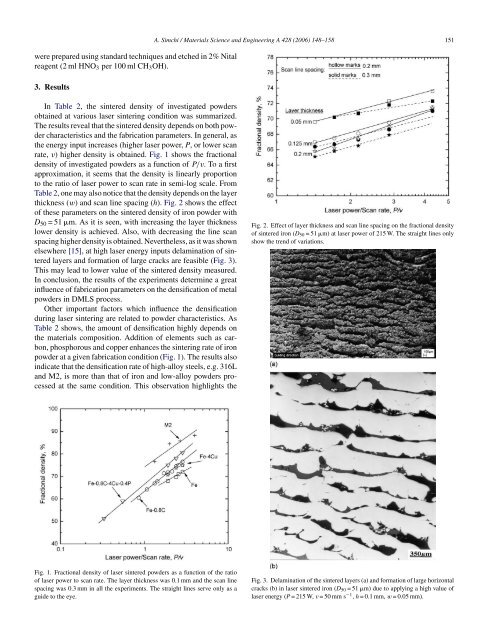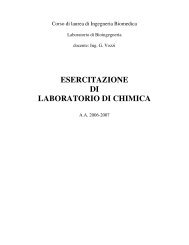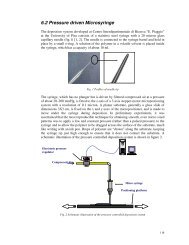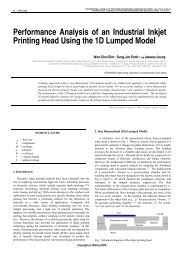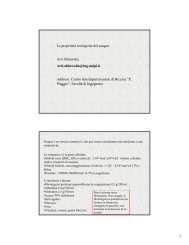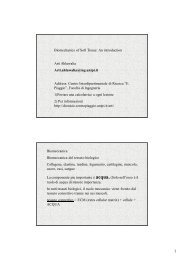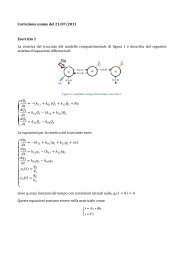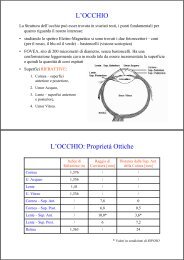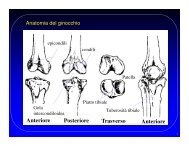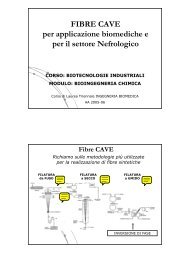Direct laser sintering of metal powders: Mechanism, kinetics and ...
Direct laser sintering of metal powders: Mechanism, kinetics and ...
Direct laser sintering of metal powders: Mechanism, kinetics and ...
- No tags were found...
Create successful ePaper yourself
Turn your PDF publications into a flip-book with our unique Google optimized e-Paper software.
were prepared using st<strong>and</strong>ard techniques <strong>and</strong> etched in 2% Nitalreagent (2 ml HNO 3 per 100 ml CH 3 OH).3. ResultsA. Simchi / Materials Science <strong>and</strong> Engineering A 428 (2006) 148–158 151In Table 2, the sintered density <strong>of</strong> investigated <strong>powders</strong>obtained at various <strong>laser</strong> <strong>sintering</strong> condition was summarized.The results reveal that the sintered density depends on both powdercharacteristics <strong>and</strong> the fabrication parameters. In general, asthe energy input increases (higher <strong>laser</strong> power, P, or lower scanrate, v) higher density is obtained. Fig. 1 shows the fractionaldensity <strong>of</strong> investigated <strong>powders</strong> as a function <strong>of</strong> P/v. To a firstapproximation, it seems that the density is linearly proportionto the ratio <strong>of</strong> <strong>laser</strong> power to scan rate in semi-log scale. FromTable 2, one may also notice that the density depends on the layerthickness (w) <strong>and</strong> scan line spacing (h). Fig. 2 shows the effect<strong>of</strong> these parameters on the sintered density <strong>of</strong> iron powder withD 50 =51m. As it is seen, with increasing the layer thicknesslower density is achieved. Also, with decreasing the line scanspacing higher density is obtained. Nevertheless, as it was shownelsewhere [15], at high <strong>laser</strong> energy inputs delamination <strong>of</strong> sinteredlayers <strong>and</strong> formation <strong>of</strong> large cracks are feasible (Fig. 3).This may lead to lower value <strong>of</strong> the sintered density measured.In conclusion, the results <strong>of</strong> the experiments determine a greatinfluence <strong>of</strong> fabrication parameters on the densification <strong>of</strong> <strong>metal</strong><strong>powders</strong> in DMLS process.Other important factors which influence the densificationduring <strong>laser</strong> <strong>sintering</strong> are related to powder characteristics. AsTable 2 shows, the amount <strong>of</strong> densification highly depends onthe materials composition. Addition <strong>of</strong> elements such as carbon,phosphorous <strong>and</strong> copper enhances the <strong>sintering</strong> rate <strong>of</strong> ironpowder at a given fabrication condition (Fig. 1). The results alsoindicate that the densification rate <strong>of</strong> high-alloy steels, e.g. 316L<strong>and</strong> M2, is more than that <strong>of</strong> iron <strong>and</strong> low-alloy <strong>powders</strong> processedat the same condition. This observation highlights theFig. 2. Effect <strong>of</strong> layer thickness <strong>and</strong> scan line spacing on the fractional density<strong>of</strong> sintered iron (D 50 =51m) at <strong>laser</strong> power <strong>of</strong> 215 W. The straight lines onlyshow the trend <strong>of</strong> variations.Fig. 1. Fractional density <strong>of</strong> <strong>laser</strong> sintered <strong>powders</strong> as a function <strong>of</strong> the ratio<strong>of</strong> <strong>laser</strong> power to scan rate. The layer thickness was 0.1 mm <strong>and</strong> the scan linespacing was 0.3 mm in all the experiments. The straight lines serve only as aguide to the eye.Fig. 3. Delamination <strong>of</strong> the sintered layers (a) <strong>and</strong> formation <strong>of</strong> large horizontalcracks (b) in <strong>laser</strong> sintered iron (D 50 =51m) due to applying a high value <strong>of</strong><strong>laser</strong> energy (P = 215 W, v =50mms −1 , h = 0.1 mm, w = 0.05 mm).


